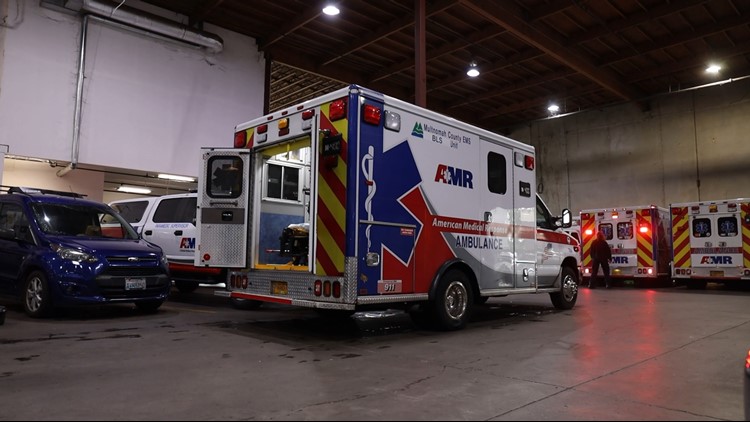PORTLAND, Ore. — A few months after a crisis in Multnomah County's emergency medical system came to a head , ambulance provider AMR reports that it is almost in compliance with response time standards — a nigh-miraculous turnaround. For years, AMR's ambulance response times in Multnomah County failed to meet those standards and only seemed to be getting worse, resulting in paramedics showing up late to 911 calls, if they were available to respond at all.
But in August, county leaders and AMR agreed to a compromise . The county, which previously required two paramedics per ambulance, allowed AMR to staff some ambulances with a hybrid crew of one paramedic and one EMT. The ambulance provider had been lobbying for this change, claiming it would help them get more crews out on the road.

Over the last six months, active on-shift ambulance increased from about 300 active shifts to more than 500. Hybrid ambulance crews working each month grew from 33 in August to 52 now. AMR's response record is now just a few percentage points away from meeting every county standard.
READ MORE: AMR’s ‘Earn While You Learn’ program graduates 8 new EMTs aiming to boost staffing The county policy shift has been a gamechanger for first responders, AMR Regional Director Rob McDonald told Multnomah County commissioners on Tuesday. "Near the end of 2024, it was not uncommon for our crews to run as many as 10-12 calls in a 12-hour period. Crews are now running a much more manageable 5-7 calls in a 12-hour shift," MacDonald said.
"This workload mitigation has provided improved work-life balance for our paramedics and EMTs. We now have the power to mitigate workforce fatigue and burnout, whereases prior to the settlement agreement, our workforce was simply surviving under an onslaught of call volume with limited resources to respond." The most concerning part of the problem at its peak was when ambulances were completely unavailable for emergency calls, a category known to dispatchers as "Level Zero.
" The code means all ambulance crews are already accounted for, and dispatch has no crews to send. Before August, KGW investigations found thousands of emergency calls listed as Level Zero. Now, those cases have been all but eradicated.
READ MORE: Portland man died waiting for ambulance that didn't arrive for 32 minutes "It was common to have as many as 20-30 hours a week where no ambulances were available to respond to a 911 call," said Andrew Cherry, AMR Multnomah County operations manager. "Working with MCEMS, we have been able to drastically decrease this occurrence to just minutes a week, and in the last week of March, that time was zero." But there remains one area where AMR is still missing the mark: response times.
The company is required under its contract with the county to respond to 90% of life-threatening calls within certain timelines. In urban areas, that threshold is eight minutes. At last check, AMR was at 88% compliance with that metric.
For nearly two years, AMR's response time compliance hovered around 60%, meaning about one in three ambulances were late in getting to an emergency call. Multnomah County commissioners and EMS leaders said they were impressed by the improvements, even if response time compliance is a few percentage points away. But the county still views the hybrid ambulance crew model as a short-term change, with the goal of eventually reverting back to a two-paramedic requirement.
"The agreement was intended by both parties to be a temporary change, a stopgap to allow AMR sufficient time to hire enough paramedics and EMTs to adequately staff enough ambulances to meet response times," said Dr. Richard Bruno, Multnomah County's health officer. READ MORE: Multnomah County's 2-paramedic requirement and the clash over 911 solutions The primary reason to switch back, from the county's perspective, comes down to health outcomes.
County leaders have cited studies showing that two paramedics provide better patient care than hybrid crews — but in Multnomah County, the difference in outcomes is not so clear. "I don't think we can give you a good answer about whether the quality of care has changed between a dual-staff paramedic ambulance or a hybrid ambulance at this point, which is why we're getting somebody on board to be dedicated to answering that question," said Aaron Monnig, Multnomah County health operations manager. If that difference can't be demonstrated here, then Commissioner Julia Brim-Edwards signaled that she's open to making the exception permanent.
"Is there some impact on the quality of care, because if not, then we should be making a more permanent shift to something like this, if it allows us to get more ambulances and speed up delayed times," Brim-Edwards said. Finally, there's the issue of AMR owing some $8 million in fines racked up for failing to meet the standards of its contract with the county. Multnomah County and AMR plan to revisit the settlement agreement and those fines in August.
.
Politics

After an emergency services crisis in Multnomah County, AMR says it's nearly caught up

The ambulance provider for Multnomah County is now just shy of meeting county standards for response times. A year ago, that was unthinkable.















